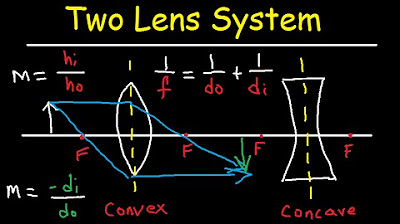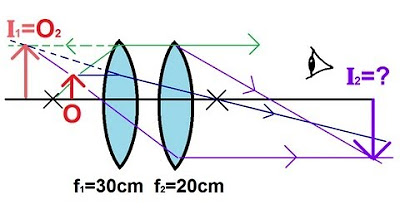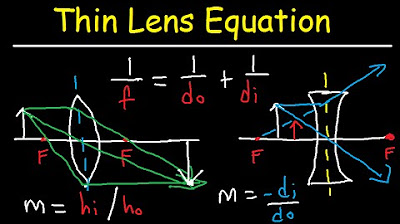The Difference Between Real & Virtual Images | Geometric Optics | Physics Demo
TLDRIn this educational video, the host clarifies the common misconception about virtual and real images in optics. Using a garage setting, the demonstration involves a convex lens to show a real image, which is inverted and smaller, formed on a wall at a specific distance. The real image is distinguished by its ability to be projected onto a surface. In contrast, a virtual image, like a tiny jeep inside a concave lens, appears on the same side as the object but cannot be projected. The video effectively illustrates the difference between the two types of images in an engaging and accessible manner.
Takeaways
- 🔎 The video is about explaining the difference between real and virtual images formed by lenses and mirrors.
- 🏠 The demonstration takes place in a garage, using objects across the street as examples.
- 🚗 Light from a neighbor's jeep and house is used to demonstrate the image formation through a convex lens.
- 🌟 A real image is formed when light passes through a lens and focuses at a particular point, appearing inverted and smaller on a surface.
- 📷 The real image can be projected onto a wall or surface when the lens is at the correct distance.
- 🔍 A real image is considered 'real' because it can be displayed on a surface or is on the opposite side of the lens from the object.
- 🪞 The video also demonstrates the concept of a real image using a concave mirror, which projects an image onto a whiteboard.
- 🖼️ In the case of a mirror, the real image appears on the same side as the object, unlike with a lens where it's on the opposite side.
- 👋 The concept of a virtual image is introduced as an image that appears to be somewhere behind the lens or mirror but does not project onto a surface.
- 👀 A virtual image is seen as if it's inside the lens or mirror, such as a tiny jeep inside a concave lens.
- 👋 The video concludes by summarizing the key differences between real and virtual images in the context of lenses and mirrors.
Q & A
What is the main misconception about lenses that the video aims to clarify?
-The main misconception the video aims to clarify is the difference between a real image and a virtual image formed by lenses.
What is the purpose of demonstrating the concept in a garage setting?
-The purpose of demonstrating the concept in a garage is to use real-world objects, such as the neighbor's jeep and house, to illustrate the formation of real and virtual images with a lens.
What is the difference between a real image and a virtual image?
-A real image is formed when light rays converge to form an image on a surface opposite to the object, while a virtual image appears to be on the same side as the object but does not actually project onto a surface.
How does the video demonstrate the formation of a real image with a convex lens?
-The video demonstrates the formation of a real image by placing a convex lens near a wall and adjusting its distance until the light focuses and forms an inverted and smaller image on the wall.
What is the significance of the inverted and smaller real image formed by the convex lens?
-The inverted and smaller real image signifies that the image is on the opposite side of the lens from the object, which is a characteristic of real images formed by convex lenses.
Why does the video use a concave mirror to illustrate the concept of a real image?
-The video uses a concave mirror to show that a real image can also be formed on the same side of the mirror as the object when projected onto a surface, like a whiteboard.
What is the difference between the real image formed by a mirror and that by a lens?
-The difference is that a real image formed by a mirror appears on the same side as the object, while a real image formed by a lens appears on the opposite side.
How does the video explain the concept of a virtual image?
-The video explains a virtual image by showing an example of an image that appears to be somewhere behind the lens or mirror, such as a tiny jeep inside the lens, which does not project onto a surface.
What is the significance of the virtual image appearing to be 'inside' the lens or mirror?
-The significance is that a virtual image appears to be somewhere behind the lens or mirror, giving the illusion of depth, but it does not actually exist in that location and cannot be projected onto a surface.
How does the video use the example of a person videotaping to illustrate a virtual image?
-The video uses the example of a person appearing to be inside the mirror, as if there's a tiny version of the person recording everything, to illustrate the concept of a virtual image.
What conclusion does the video draw about the difference between real and virtual images?
-The video concludes that the key difference between real and virtual images is whether they can be projected onto a surface, with real images being projectable and virtual images appearing to exist in a space but not being projectable.
Outlines
🔎 Understanding Real and Virtual Images
In this garage-based tutorial, the presenter aims to clarify the common misconception about the difference between real and virtual images in optics. Using a convex lens, the video demonstrates how light from a neighbor's jeep and house is focused to form a real image on a wall at a specific distance from the lens. The real image is inverted and smaller, and it's considered 'real' because it can be projected onto a surface. The video contrasts this with a concave mirror, which also forms a real image on the same side as the object, but only when reflected onto a surface like a whiteboard. The presenter then introduces the concept of a virtual image, which appears to be behind the optical device and does not project onto surfaces, using the examples of a virtual image of his wife in a mirror and a tiny jeep inside a concave lens.
Mindmap
Keywords
💡Ray tracing
💡Virtual image
💡Real image
💡Convex lens
💡Concave lens
💡Focal point
💡Inverted image
💡Hologram
💡Projection
💡Optics
💡Whiteboard
Highlights
Introduction to the misconception about virtual and real images in lens optics.
Explanation of ray tracing diagrams involving objects and images.
Demonstration of a real image formed by a convex lens using natural light.
Clarification that a real image is not a hologram but focuses at a particular point.
Description of the process of a real image formation on a wall with a convex lens.
Illustration of the concept of focus and out-of-focus images with a lens.
Definition of a real image as one that can be projected onto a surface.
Observation of the inverted and smaller size of a real image formed by a convex lens.
Comparison of real image formation with a mirror versus a lens.
Use of a concave mirror to demonstrate real image projection on a whiteboard.
Explanation of real image appearance on the same side as the object with a mirror.
Introduction to the concept of a virtual image as opposed to a real image.
Demonstration of a virtual image appearing to be inside a mirror or lens.
Description of a virtual image as one that does not project through the lens.
Comparison between the appearance of virtual and real images in different optical devices.
Final summary of the differences between real and virtual images in the context of the garage experiment.
Transcripts
Browse More Related Video

GCSE Physics - How to Draw Ray Diagrams #70

Multiple Two Lens System with Diverging and Converging Lens

What are Real and Virtual Images? | Reflection of Light | Infinity Learn

Physics - Optics: Lenses (2 of 5) Lens Combinations - Two Converging Lenses

Thin Lens Equation Converging and Dverging Lens Ray Diagram & Sign Conventions

Concave Mirrors and Convex Mirrors Ray Diagram - Equations / Formulas & Practice Problems
5.0 / 5 (0 votes)
Thanks for rating: